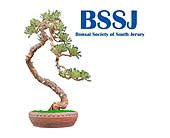

Saturday at at Clover Gardens, Marlton N.J., Ski Dombrowski explained and demonstrated the air layering technique he has used successfully for many years, to BSSJ club members.
Ski used a Full Moon Maple as his subject.
Technique:
The right-hand branch was selected to layer off. Ski used a large-diameter copper wire to form a tourniquet around the base of the branch, placed at the point where he wants roots to form. The roots will come out just above the wire.
When applying the wire, it is tightened with pliers until 1/2 of the diameter "crushes" the cambium. Ski explained that smaller diameter wire will cut the cambium, which will likely kill the branch, hence the use of larger diameter wire.
Once the wire tourniquet has been placed, several "nicks" should be made into the cambium, above the wire. This helps the tree to absorb the rooting hormone easily. The nicks and branch are wetted with sprayed water. The rooting hormone is picked up using a small brush, and "flicked" onto the wetted area. Moistened clay is then placed over and around the hormoned area, to hold hormone in place.



Ski then measured the length of the branch where roots need to be: 2 inches. He then sized the plastic covering which is applied next: length = 5 X (length to have roots) = 10 inches. Width of the plastic is 1/2 of that, so the resultant plastic sheet is 5X10 inches.
The plastic sheet was cut, and a "bag" formed. This was fitted down over the branch, and gathered at the branch base, below the wire. This gathered section is then tied using strong string (which has a little "give", like multi-strand fishing line).
Ski then poured a mixture of sphagnum moss and soil mix into the bag, and tamped it firmly into place. When full, the bag was tied off at the top.



Once the bag is firmly mounted, tied, and filled, medium-sized holes are made into the plastic bag at the top. This allows water to be added from a small watering can, or a turkey baster. A sharp wooden skewer was used to puncture the bag many times all over the bag. This allows excess water to escape, so it does not form a puddle at the bottom, which is potential for rot.
Once this is completed, water is added into the bag, and the air layering begins!



AfterCare:
Since the plastic is clear, the rooting process is easily checked. Water will stay in the bag for comparatively long periods, so only needs to be refreshed every week or two.
Once the roots grow out, they will be whitish in color. It is best to wait until the root tips turn brown before separating the rooted branch.
At separation, extreme care must be given to the rooting mass, so that the new fine roots are not bumped or moved, which will likely break them off.
The whole rooting process can take 6 to 10 weeks, depending on species.
On conifers, the rooting process may well take several seasons, so patience is required.
Ski explained that he has had virtually 95% success rate with this technique. Given that it is so easy to implement, why would anyone want to propagate with more difficult methods?
Thanks Ski, for the informative lesson!
Flex

Hey, these are some great pics and belong on the website...I'll post them over there!!!
ReplyDelete